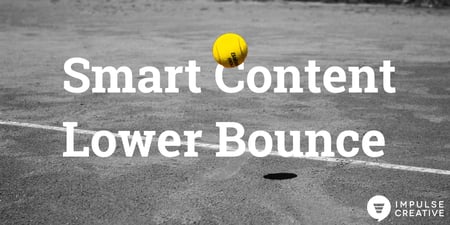How to Use Smart Content to Decrease Your Website Bounce Rate

We know that a bounce rate measures the percentage of visitors that leave your website after viewing only one page on your site. In other words, they “bounce” back to the search results or referring website.
Sure, we want to keep that number as low as possible and keep viewers on our sites. But knwo this: “high” is a relative term. Some research suggests that average websites will see bounce rates between 26% to 70%.
According to research from Rocketfuel, here’s how that breaks down:
- 25% or lower: Something is probably broken
- 26-40%: Excellent
- 41-55%: Average
- 56-70%: Higher than normal, but could make sense depending on the website
- 70% or higher: Bad and/or something is probably broken
As a reminder, for those using Google Analytics, the overall bounce rate for your site will live in the Audience Overview tab of GA.
Why do users bounce? There could be a few reasons. And not all of them are bad. Here are a few quick reasons.
Positive reasons to bounce:
- A user found what they were looking for on the first page (this is why pillar pages are so important and helpful)
- You have affiliate pages that send people to the affiliate
Negative reasons to bounce:
- Slow page load time
- Inaccurate results from bad title/meta description
- Low quality or irrelevant content
Where should you start and what should you fix? You could start in a lot of places. But that can overwhelm your senses. Who wants to have paralysis by analysis?
Instead, let’s start with that last point, irrelevant content.
Even if your page has results that work for most people, it may not work for everyone. But you can design a website that uses smart content to offer relevant information that speaks to individual users.
What if your website identified people with cookies, then allowed them to self-select their position and their needs, allowing you to deliver custom content on subsequent pages?
That’s the beauty of smart content on your website.
Here’s how Impulse Creative did this.
We wanted to decrease our bounce rate on our homepage by delivering the best content. So we started by building a selector for homepage viewers to segment themselves. This helped us first better understand our audience.
At its heart, the homepage selector begins to give us context. A contextual conversation begins with precise targeting.
Since we use tools that all connect and work with each other, we created the selector on our HubSpot-hosted page, funneled the data into our HubSpot CRM, then connected our Drift chat tool. Now we’re offering relevant homepage content and having contextual conversations in Drift as well.
With the data we collected, we were able to add smart content to the homepage first, then deeper into the site on service pages, speaking directly to viewers. This allowed us to customize messaging to make it more useful to our known contacts. It even lasts beyond the initial visit, keeping our website more relevant to users anytime they return.
For instance, when a user chooses that they want more leads, we’ll offer content throughout the site on blogging, lead generation, and other inbound marketing tactics.
We saw immediate results on lowering our bounce and exit rates when we implemented these solutions. Then, more than six months later, we still see a great improvement.
Our Smart Content Exit rate is 30% less than default content. In other words, known users are more engaged than before. Rather than exit from that page, they’re moving through our site. Visiting deeper pages.

We have also found them sticking around on those pages longer, with “time on page” 15% longer.
The click-through-rate (CTR) to our company page (who is Impulse Creative?) and our service pages (what can they do?) is working much better. That was a goal of ours at the onset of this project.
- 5% of our traffic since Feb 2019 goes to services and data is cleaner - people going to specific areas where we want them to
- Previous period was scattered and only 3% went to services
- 25% went to company page vs 17% company page between those two periods
How Can You Take Advantage of Smart Content?
Build smart content into your website strategy and design. When you can show relevant “what readers like you love” content, users are much more likely to keep clicking and stick around. It’s the Amazon/Netflix/Buzzfeed model. You may not be entertaining users, but you’re giving them valuable content. Or at least, you should be.
When you know the user is looking for help with a specific need, show them content that reflects that need. Irrelevant content will push people to bounce every time.
Also, when you can include tokens like company in your content, go for it. That’s what we do at Impulse Creative on our home page.
We help businesses like yours grow by helping you navigate through today’s leading technologies, marketing channels, and tactics to deliver the right experience for your brand and customers.
The word yours is bolded because that is a personalization token. When our system knows your company, it’s replaced there. So it would read “We help businesses like [ABC Company] grow…
This little change can make a huge difference in reducing bounce rate and keeping people around.
BONUS: What about responsive design? Does your messaging change if your viewers are mobile? Here’s what viewers see when they’re on mobile devices.
Marketing is always on the move, just like you (on your mobile device). We help you leverage strategies with the right content at the right time with mobile optimized websites & campaigns.
Looking to measure the effectiveness of your website and marketing efforts? Take the Conversion Report quiz below. Or if you know you want to decrease your bounce rate with smart content but aren’t sure how, let us help.




